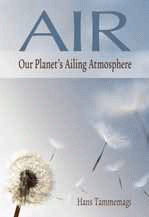SEJournal Online is the digital news magazine of the Society of Environmental Journalists. Learn more about SEJournal Online, including submission, subscription and advertising information.

BookShelf
Air: Our Planet's Ailing Atmosphere
By Hans Tammemagi
Oxford University Press, $27.95
Reviewed By JIM MOTAVALLI
In 1944, Japanese high-altitude bombers discovered the near-magical properties of the jet stream and decided to exploit it as a weapon of war. They obtained 9,000 balloons, attached bombs to them, and set them adrift, assured by emerging science that they'd travel east across the Pacific to the west coast of the U.S. The bombs were supposed to go off on making landfall, but a fortunate miscalculation — the wet-cell batteries that powered the onboard electronics froze at six miles of altitude — meant that most of them failed. But one made it all the way to rural Bly, Oregon and killed a teacher and five kids on a Sunday school outing.
The story of those unfortunate kids, victims by chance, haunts me. It's told in one of many informative sidebars in SEJ member Hans Tammemagi's book about air, a substance most of us take for granted because we can't see it or reach out and touch it. His book is probably the best that could be written about the air around us, combining a skillful and learned description of our planet's fragile atmosphere and what lays beyond it with a detailed and angry analysis of the harm we've done and the peril we're now in.
The early chapters of the book would make an elegant narration for a National Geographic special. Tammemagi, the environmental columnist at the Vancouver Sun, writes with complete authoritative command of his material. The reader discovers, for instance, that "the exosphere, which lies beyond the thermosphere, above 435 miles, is an austere region with very sparse gases. An atom must travel several kilometers before bumping into its nearest neighbor." I can get a vivid picture out of that.
We further learn that "the protons in the inner Van Allen belt have such high energy that they can penetrate several centimeters of lead." And then we're told about Van Allen, the space scientist. And about a much earlier French atmospheric pioneer, Blaise Pascal (1623-1662), the first person to realize that air had mass, after carrying a barometer up a hill.
This is ace science writing, never less than elegant. Tammemagi fully reveals the beautifully complex, intricately designed collusion of gases that allows the Earth to be the only planet we know of capable of supporting complex life forms. He takes us through the scientific discoveries that taught us what we now know, and through the atmosphere's four distinct layers into the outer reaches of space (where we don't know much at all).
If the book had stopped there, it would probably have won some obscure but prestigious prize, earned some respectful reviews, and that would have been that. But Tammemagi wants us to know that our planet's atmosphere is under attack, and that inspires the second part of his book — angrier, despairing of humanity's folly and not so elegant. It's about global warming and what caused it (mainly our insistence on burning fossil fuels), and why it took an underfunded British scientist, Joe Farman, to notice that there was a gaping hole in the ozone layer over Antarctica.
There are a lot of good books on global warming, including very alarming new ones from both Bill McKibben and James Hansen, so Air loses its literary distinctiveness here. Tammemagi does as good a job as anyone in explaining the science, but its complexity (warning — charts and chemical formulas coming up) may lose some readers caught up in the earlier magic.
The transportation chapter covers the important bases but also relies on many older studies. Its workman-like prose is a disappointment after what came before. The section on how a wellmeaning General Motors chemist, Thomas Midgley, gave us not only lead in gasoline but also ozone-killing chlorofluorocarbons (CFCs) is fascinating, but some passages are perfunctory or dated. Cars haven't had carburetors for more than 30 years, so we can't control evaporative emissions by sealing them up. The few paragraphs on electric cars are inadequate to such an important subject — you'd never know we were on the verge of a plug-in revolution that will put at least five new models on the road before the end of this year.
Like other writers on this terrain, Tammemagi has a nearly impossible task when it comes to finding solutions for huge, intractable problems. If electric vehicles, carbon sequestration and natural gas power plants look inadequate to the task at hand, it's because they are. An author's tone could get despairing at this point, but after a textbook-like middle section, Tammemagi's style and command of telling details reasserts itself as he draws to a conclusion.
So Tammemagi says yes to smokestack scrubbers, wind turbines and photovoltaics, but like McKibben, he sees that the ultimate solution lies in curtailing economic growth, saying goodbye to fossil fuels and controlling population growth. These are enormous hurdles, so the author is forgiven for wondering if we'll get over them in time. With a nod to Jared Diamond, he invokes the cautionary tale of the Easter Islanders who overshot their carrying capacity, carrying out an environmental holocaust to build graven images (the skyscrapers of their day?) that ultimately fell into ruin along with their civilization.
Despite minor shortcomings, you'll want to keep a copy of Air handy. It's a major reference work for reporters covering the biggest story of the millennium.
Jim Motavalli is a regular blogger, mostly on clean cars, for NPR's Car Talk, The New York Times, CBS Interactive, Mother Nature Network, AOL and Hearst's Daily Green. He is working on a book about electric vehicles for Rodale.
* From SEJ's quarterly newsletter SEJournal, Summer 2010 issue.













 Advertisement
Advertisement 



